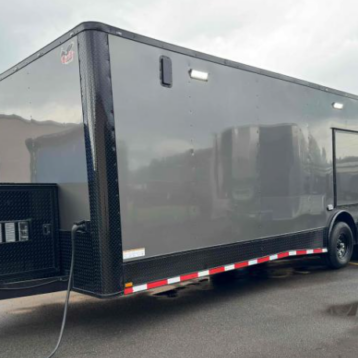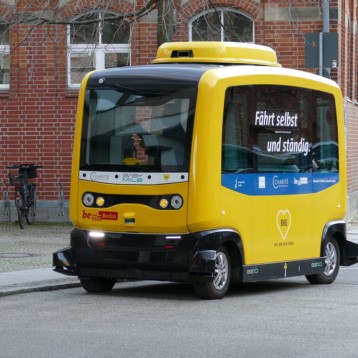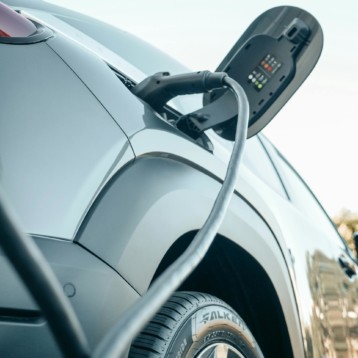|
Prevalent methods of public transportation suffer from one of two problems: Lacking space for a large number of people (buses), or lacking the ability to dynamically steer through small places and adjust courses according to traffic (subways, trams). Now, Fraunhofer Institute is researching a combined solution, as part of the “System Research on Electric-Powered Mobility” project.
Multiple departments are involved in this extensive project, and therefore decided to break the work into four areas of focus: Vehicle concepts; energy generation, distribution and conversion; energy storage technology; and technical system integration and social issues. The original design intent of the AutoTram was to provide a platform for researchers to test new developments in these areas, not only in simulations but also in the real world. New modules for energy storage, double-layer capacitors, and coupling come installed in the vehicle directly from the Fraunhofer research laboratories to allow them to prove their capabilities in the field. Recently, they have presented their first results.
One challenge the engineers faced is the vehicle’s high-utilization rate. While cars remain parked for more than 20 hours a day, buses and trams are in constant motion; the problem is it doesn’t leave much time to recharge the batteries. One solution the AutoTram offers is fast-charge docking stations positioned at the stops along the route. With this configuration, it is possible to draw current at every third or fourth stop. The requisite amount of energy required for recharge in just 30 to 60 seconds is more than 1,000 amperes and 700 volts. The reason for the short time limit is the designers’ wish to refrain from delaying passengers.
To accomplish this in such a short period, super-capacitors are used. Researchers are working to develop the modules required, using double-layer capacitors placed on high-performance converters and on contact systems for the transmission of current. Unlike batteries, double-layer capacitors – also known as “supercaps” – have a high power density. Those capacitors ensure that the charge can be quickly stored.
“Batteries take their time charging. You can compare this to a big bathtub with a small spigot. Capacitors, on the other hand, quickly take up the charge, like a small bathtub with a large spigot,” said Dr. Ulrich Potthoff, department head at the Fraunhofer Institute for Transportation and Infrastructure Systems IVI. On the other hand, there are drawbacks; “They can only store a smaller quantity of energy, “ Potthoff said. Engineers are working on linking the battery system with the capacitors for this application in city traffic.
Other researchers at the Fraunhofer Institute for Integrated Systems and Device Technology IISB are contributing innovative developments for the power-electronic components, such as a direct voltage converter that adjusts the voltage level. “We’re developing dual storage units and testing their features in combination with other storage types and fuel cells,” explains Potthoff. These DC/DC converters are necessary to link the double-layer capacitors with the drive train.
One major factor that the team tries to address is choosing the right materials, which have to withstand transmission of high levels of current. The surface of the contacts must be very stable and wear-resistant. In this regard, the scientists came up with suitable materials and the methods for processing them. Every new concept must be coordinated with existing ones, so “they will harmonize with all of the other components,” said Potthoff. “At IVI, we are incorporating the modules into the overall AutoTram system and configuring the interfaces.”
These interfaces include the lithium-ion battery systems for electric vehicles. This is an effort to which experts at 11 different Fraunhofer Institutes have been working to advance; – not an easy task, as the batteries and electrical systems are subject to extreme demands—safety, durability, and efficiency are all required equally.
The team addressed safety first. Usually, the battery system consists of several hundred cells, and these do not always discharge at the same rate. And, if individual cells should fail or no longer deliver the intended performance, this can take a toll on the entire battery. The individual cells are controlled using an overarching energy-management system, measuring the current almost immediately. “Within a few fractions of a second, the electronics measure the current, the voltage in the individual cells, and the temperature, and use these parameters to derive values for the battery’s state of charge and health,” explains project manager Dr. Matthias Vetter of the Fraunhofer Institute for Solar Energy Systems. “This way, a determination can be made for each cell as to whether there are any threats of overload, deep discharge, excessive heating, or premature aging.”
According to Vetter – who acts as the team coordinator – the project is also looking to develop a new type of magnetorheological engine-generator coupling. Electrically switchable coupling works by altering the consistency of an integrated fluid from liquid to solid under the influence of a magnetic field. Scientists can harness this reaction to provide precision control of the coupling process. Equipped with highly efficient electric drive motors and control units as well as high-performance batteries and supercapacitors, the AutoTram could transport its guests with nearly zero emissions.
Although the AutoTram is far from being a fully functional, operating vehicle, these first results could lead the researchers to implement advanced technologies in the near future.
TFOT also covered the Non-Stopping Train, a futuristic vehicle invented by Peng Yu-lun from Taiwan.
For more information about the AutoTram, see the official press release.











